BMW’s 5-Series takes on the E-class, XF and S90 in a bid to be the best mid-size luxury sedan currently on sale in India.
Earlier this year, Mercedes disrupted the segment when it launched the long-wheelbase E-class, which redefined the chauffeur-driven experience in this category. Now, BMW has introduced an all-new 5 that’s crammed with tech and promises ‘Sheer Driving Pleasure’. Both cars compete against some delectable rivals - the capable Volvo S90 and the sporty-looking Jaguar XF.
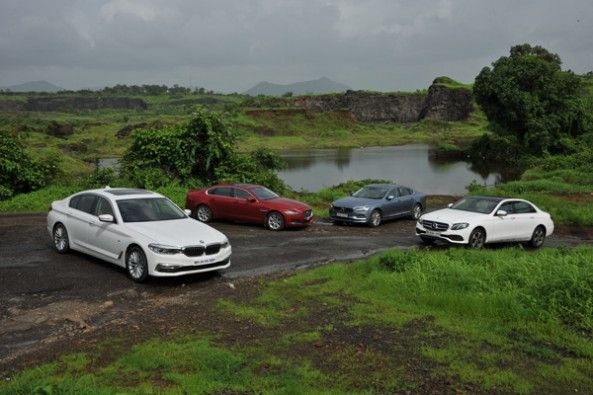
All these cars are fitted with four-cylinder diesel engines in the highest trim available. Mercedes and Volvo offer only one trim, while the Jag and BMW can be had in less expensive lower variants.
On the outside
The S90 shies away from being too sporty and wears a square-edged Scandinavian look. The E-class looks quite elegant too, in true Mercedes fashion – the design is very regal with its flowing lines and rounded roof, and since this is the long wheelbase car, it looks visibly stretched-out like a limousine. The Jag is by far the sportiest and most aggressive looking of the lot.
The new 5-series, in its Luxury Line trim, is a bit of a disappointment - it tends to look smaller than it is, and a bit ordinary. However, it does tick all the correct luxury car boxes, with generous doses of chrome, a wide stance and some nice detailing in the bodywork.
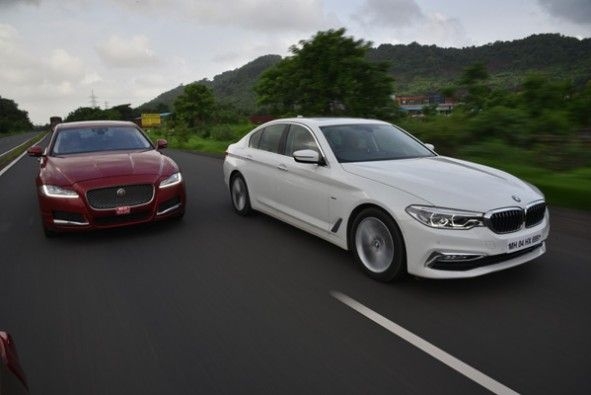
On the inside
The new 5 borrows a lot of bits from the 7-series - the thick slabs of wood on the dashboard and doors, added metallic accents on the dashboard and quality levels that’s at par with the bigger car. A few bits like the metal window and steering switches feel low rent, but overall, BMW’s dash and interior feel a little too business-like.
The E also follows a similar path, it looks like a mildly scaled-down S-class – it comes with knurled metal knobs, swathes of un-veneered wood and then there’s the massive 12.3-inch infotainment screen at the centre. However, Mercedes doesn’t offer its digital instrument cluster option in India (in fact, it’s the only car here without this feature). The analogue dials, however, are clear, but they look a bit plain, and they sit in a rectangular frame which, on the car abroad, houses a second 12.3-inch screen.
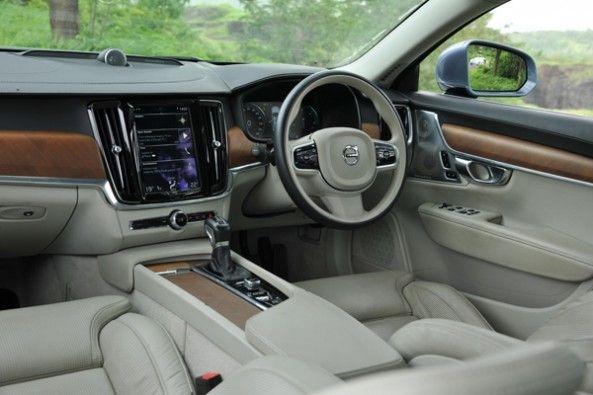
On the inside, the Volvo’s cabin is fantastic to look at and refreshing in terms of design. The portrait-oriented touchscreen, flanked by tall AC vents, and the thick chunks of wood and large pieces of metal used for bits like the door handles and the speaker grilles all come together to make this cabin a wonderful place to be sat. We did wish a few basic controls, like climate control, had physical buttons, using the touchscreen on the move proves cumbersome.
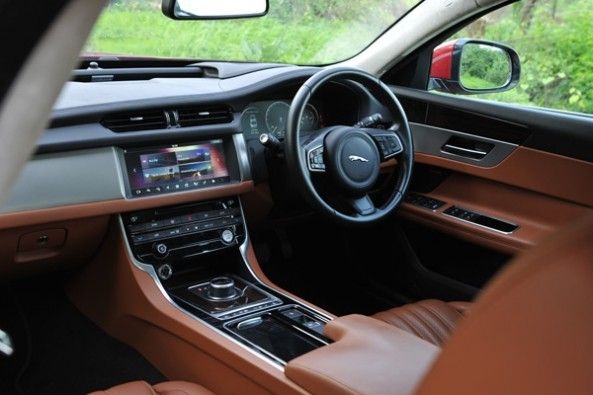
The XF is fitted with a neat 12.3-inch touchscreen too, and it has those vital physical control buttons. Jaguar’s signature rotary knob rises through the centre console on startup and works as the gear selector. The dash is wide, as is the central console, and it’s all very neat, but it just doesn’t feel special enough. Some bits feel out of place on a car this expensive.
While all cars offer a massive boot on paper, the space saver placement is what makes the difference. The Jag and Volvo have spare tyres that don’t intrude into the luggage area. The E-class, disappointingly, still has its space-saver sitting in the boot, held in place by straps, and the tyre eats into the luggage area. BMW has provided a covered casing that holds the spare and tool kit. This eats up a lot more space, but at least you get a flat loading bay, and it’s still enough to hold a couple of suitcases.
Equipment standards in this class are quite high – all these cars come with powered front seats, push-button start, LED interior ambient lighting, dual-zone automatic climate control and LED headlamps.
The Volvo and BMW come with four-zone climate control, the Mercedes gets three-zone, and the Jaguar gets two-zone. The Jag and Volvo have more adjustable front seats, and the S90 comes with heated and cooled seats too. They all feature large infotainment screens, but the Merc’s is not touch-sensitive, while BMW’s iDrive is now not only touch-sensitive, but you can use the traditional click-wheel, touchpad and it even comes with gesture controls. All cars have hands-free parking assist features, the BMW also gets the cool ‘remote’ parking system (which lets you start and move the car without actually sitting in it). The Bimmer and Jag are also the only ones to get 360-degree cameras.
Only the E-class gets both Android Auto and Apple CarPlay, although the S90 does offer the latter. The S90 and the XF feature a heads-up display too. Volvo is rolling out its ‘Intellisafe’ suite of radar-guided safety systems, including pedestrian and vehicle detection, traffic sign recognition, adaptive cruise control and auto emergency braking. The Jag comes with All Surface Progress Control and BMW gives you adaptive dampers as standard on all 5-series models. The E-class’ rear bench has features like reclining backrests, electric window blinds and the ability to move the front passenger seat. It also has controls for the sunroof and rear sunblind on each rear door. It, however, doesn’t have seat memory at the front, and cupholders at the rear.

The seats of the E are sumptuous – the front seats are relatively snugs. The Jaguar and the Volvo, use slightly firm cushioning but the chairs themselves are well designed and support you in all the right places. The BMW’s front seats are big, soft comfortable things that will suit any body shape.
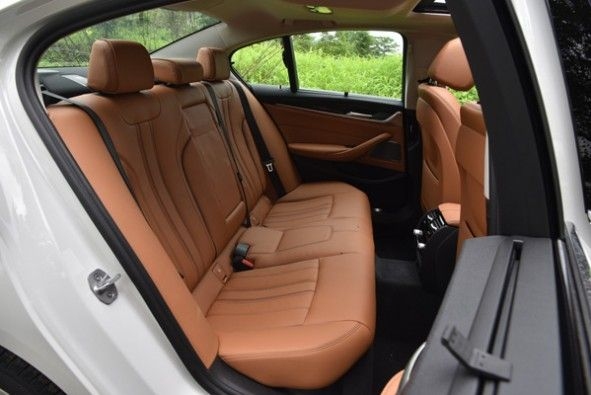
As far as backseat experience goes, the Jag is the great. Despite its heavily sloped roof, you get a lot of headroom, legroom is excellent too and support is just fantastic. The Volvo too has loads of space in the back seat, but the seat itself isn’t great on thigh support, and like the front, the cushioning is a tad firm. The 5-series’ back seat is really comfortable too - legroom and headroom are ample, although some might find the backrest a little too upright. The long-wheelbase E-class is the cabin to be chauffeured around in. While some might find stepping through the relatively narrow door and leaning back into the chair a bit awkward, these are just minor grouses. The amount of space you get, amplified by the massive panoramic sunroof and the recline function all work to make this the best rear bench here.
From behind the wheel
The E-class rides like a limousine – it’s ride is set on the softer side and so bump absorption at lower speeds is really very good. The car however tends to float about quite a lot at higher speeds. The car is very quiet at idle, but overall noise levels are the highest of this group.
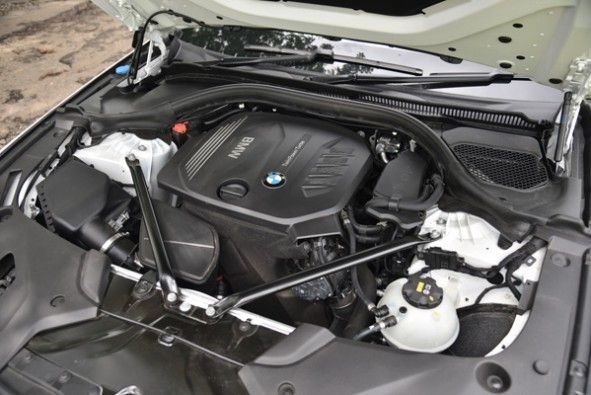
The 520d’s levels of refinement are impressive. At any speed, stationary or on the move, it tested the quietest. In either ‘Comfort’ or ‘Sport’, the car rides really well. Even on uneven roads, vertical movement is more frequent, but of much smaller magnitude than you’ll feel in the E-class.
For passengers at the back, the Volvo offers a soft, cushy ride along the same lines as the Mercedes. However, this car moves around quite a bit, but the bigger concern is its low ground clearance, it tends to scrape over speed bumps. The motor was the noisiest of the bunch at idle, but it smoothens out and quiets down once you get moving. Very little road noise finds its way into the cabin.
The Jag XF feels the firmest, but it is far from uncomfortable. The occasional bumps filter through, but this car feels the most stable at high speeds. Yes, the motor does get quite noisy at idle, but when it’s not revving hard, the car itself is pretty quiet on the move.
The BMW and the Jaguar are definitely the ones you want to pick if you drive yourself from time to time. The new 5-series is an improvement on the older car and it’s a whole lot of fun to drive. The XF is actually a little better than the BMW on this front though. The BMW’s 190hp motor enjoys being revved while Jaguar’s new Ingenium engine, with 180hp feels strong low down and it gets off the line briskly, but shortly after, it starts to run out of breath. BMW’s version of ZF’s eight-speed automatic gearbox feels a bit smoother and quicker to react than Jaguar’s.
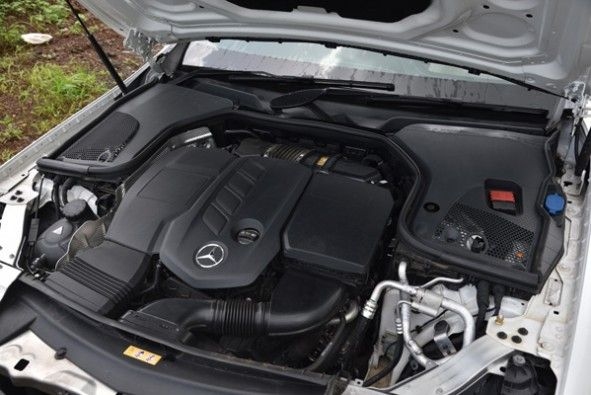
The BMW hits 100kph in just 7.74sec, while the Jag takes 9.04sec to do the same sprint. The E 220d cracks the ton in 8.81sec and the S90 in 8.5sec. Both the Mercedes and Volvo’s engines make their power in a far more relaxed and linear manner than the Jaguar or BMW.
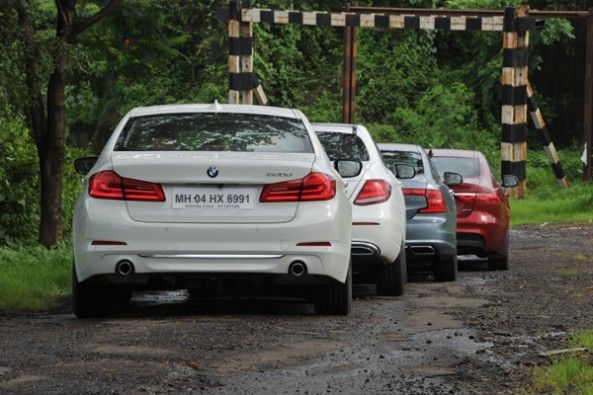
Which one should you buy?
The XF, in true Jaguar fashion, is both elegant and aggressive, and it has the chassis to match. But on the luxury front, it can’t quite keep up. Volvo’s rich interior, which continues to make you go ‘wow’ every time you step in. But performance and handling are a bit underwhelming, and rear seat comfort is not as good as the others.
Mercedes took a bold and expensive risk in bringing the long-wheelbase version to India. The back-seat experience is like nothing else at this price, and it’s enough to let you forgive its few shortcomings, like the absence of some important features. The BMW, as well, has improved in every single area - it’s absolutely loaded with tech, is more luxurious, and it’s more spacious and comfortable than ever before, plus it drives better too.
When it comes to four-cylinder diesel engines in this class, most owners prefer back-seat comfort over gizmos and driving pleasure which is why, despite it being a close tussle, the E-class wins this comparison test.






























